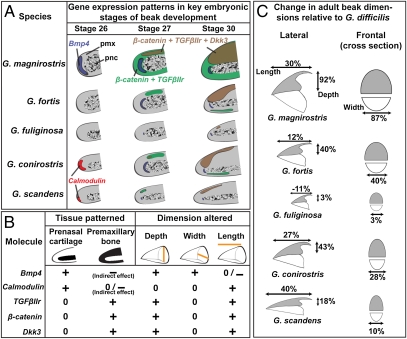Fig. 5.
The distinct beak morphologies in Geospiza are generated by differences in the time and place of expression of different genes. (A) Species with deep beaks, such as G. magnirostris and G. fortis, have earlier and broader expression of Bmp4, TGFβIIr, β-catenin, and Dkk3, whereas expression of CaM, TGFβIIr, β-catenin, and Dkk3 is localized distally in species with elongated beaks, such as G. scandens and G. conirostris. (B) Through their action on different skeletal tissues, different genes alter independent dimensions of growth. (C) The beak of the sharp-beaked finch, G. difficilis, represents a basal morphology for Geospiza (26, 37). Expression and function of the genes described here explain changes in beak dimensions of the more derived species. +, positive effect; 0, no effect; −, negative effect; pmx, premaxillary bone; pnc, prenasal cartilage. Measurements in C were taken from ref 21, corrected for wing length, and correspond to averages from males that were collected in the islands where we obtained our samples.

